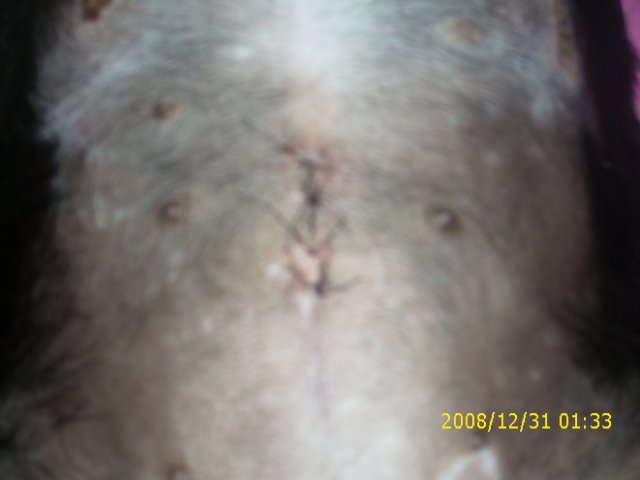QuestionI know you can't give me a diagnosis or anything for certain but I was hoping you could tell me some general knowledge about lumps and moles in dogs.
My dog has great energy (like he was still a puppy), he is very happy, and very active. He is almost 12 years old. He has several lumps and moles that have been increasing and growing over the past couple years. He has a very large mass on his back hind leg that appears to get in the way of his jumping ability however he is extremely active and happy. I brought him to the vet 5 months ago over an ear bump that he bit open and he got an overall physical. The vet said the bump on his ear would never heal if he didn't get it surgically removed but he was wrong.. it has since healed. He also examined his lumps and bumbs and said we should get a biopsy for them but didn't give any idea if it was something we should be worried about or not. He didn't seem to know.
None of his bumps have ever burst, don't look like cauliflower, or anything like that. They are increasing in size and he is getting new moles.
GENERALLY, is that a sign of concern or is it really something more 50/50 like my vet was implying? He didn't want to say one way or the other but I'm just wondering if it's something that is commonly one way or the other?
Thanks.
Melissa
AnswerHi Melissa,
I don't think your vet was implying anything, rather he was saying there is no way to guess at what your dog's growths are without having a biopsy done.
They may well be Lipomas, which are benign fatty tumors that are firm yet movable and they are painless and not associated with infection or hair loss.
It's when a growth rapidly grows or starts to become too large that it creates mobility problems that the vet performs a fine needle aspirate or biopsy to confirm that it is a lipoma.
That said, you shouldn't dismiss the growths as Lipomas by what I say, or by what you might read on line. There are some very serious tumors that appear in the skin and subcutaneous tissue and it takes a trained veterinarian to distinguish between them. For your own peace of mind, it's worth having a fine needle aspirate or biopsy done. It's easily performed and easy to verify the existence of a lipoma.
Best of luck,
Patti

 TRAINING POMERANIANS
Question
chichi&coco
I have two Pomeranian-mixed do
TRAINING POMERANIANS
Question
chichi&coco
I have two Pomeranian-mixed do
 I want to know how to remove my dogs spay stitches and the right way.
Question
this is the area that
I need to know how to r
I want to know how to remove my dogs spay stitches and the right way.
Question
this is the area that
I need to know how to r
 1 year old daschund
Question
our new member
We recently got a one year old
1 year old daschund
Question
our new member
We recently got a one year old
 Temperature before birth
QuestionQUESTION: My female cheweenie is on day 52 of h
Temperature before birth
QuestionQUESTION: My female cheweenie is on day 52 of h
 Senior dog not eating
Question
Meggie Girl
I will be so grateful if you can h
Senior dog not eating
Question
Meggie Girl
I will be so grateful if you can h